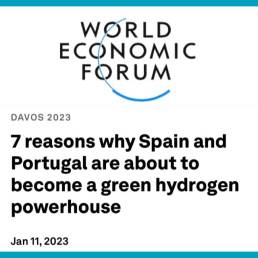7 reasons why Spain and Portugal are about to become a green hydrogen powerhouse – World Economic Forum, 11 January 2023
Green hydrogen is a highly flexible fuel that can help meet the need for energy.
The Iberian Peninsula is in a unique position to become a green powerhouse.
Spanish and Portuguese produced green hydrogen can be very cost effective.
It is hard to imagine that today’s energy crisis is anything but a bad thing. It is hitting people in the pockets and, at the same time, damaging the planet: a scramble for energy security has meant a comeback for coal. Global greenhouse gas emissions are rising.
It is, however, possible that we will look back at this moment as a critical turning point in the fight against climate change. This crisis has reminded everybody that energy is everywhere and in everything. If energy costs more, everything costs more. This is focusing minds on a number of once-in-a-generation opportunities.
An example can be found on the Iberian Peninsula, which has everything it needs to become the hydrogen powerhouse of Europe.
And make no mistake, Europe needs hydrogen.
Solar panels and wind turbines can help meet our need for electricity, but electricity is less than a fifth of the energy we use. To maximise decarbonisation, to get the most from solar and wind, we need to convert much more of our energy consumption to electricity. Yet, even if we electrify everything that can be electrified we will still only have dealt with around half of our energy use. There are many sectors that rely on fossil fuels and cannot see a way to electrify: heavy road freight, shipping and aviation…heavy industry such as steel, cement and chemicals.
Green hydrogen is likely to be a big part of the answer. It can be made by using renewable electricity to split water molecules through electrolysis, or by using biomethane. This is “green hydrogen”, and it is carbon neutral. It can be piped across long distances, compressed or liquefied. It can be used in planes, trucks and ships – converted into biofuels like biodiesel or sustainable aviation fuel (SAF), into e-ammonia and e-methanol, or even burned directly as a fuel in some cases. It can be burned like natural gas, to produce heat for industrial processes, among many other uses.
In short, hydrogen is a highly flexible fuel. That is why the UN’s climate change body, the UNFCCC, believes hydrogen could meet up to 20% of global energy demand by 2050 – about the same share of the energy system that electricity has today.
That demand is already beginning to grow. In the summer, Germany launched the world’s first network of hydrogen-powered trains.H2 Green Steel is about to start building a hydrogen-based steel plant in northern Sweden. A matter of weeks ago, Rolls-Royce started testing a new hydrogen-fuelled jet engine.
A unique opportunity
The time has come for Spain and Portugal to step forward: they are uniquely positioned to start producing green hydrogen at scale. They have seven advantages which, when combined, make for powerful momentum.
1) Lots of zero-carbon electricity already available with huge potential for more, plenty of land to expand and a diverse range of ways to generate green electrons – including solar, wind, biomass, and hydropower.
2) An unusually flexible electricity grid that is well connected across the peninsula. This means green electrons can be easily transferred from wherever they are created to wherever they are needed.
3) A wide geographical spread of zero carbon energy generation through the region. This, combined with the diversity of sources and flexible grid, allows a 24/7 supply of green electrons. This is perfect for hydrogen electrolysis, which needs a reliable and constant supply of electricity to operate efficiently.
4) A great potential for producing biomethane out of agriculture residues (like olive pits), farm wastes, biomass from forest clean-ups, and other organic waste.
5) Existing domestic demand for hydrogen. There is already enough need for hydrogen across Iberia to justify building the necessary production facilities. Once they are built, the costs of expanding further to export green hydrogen are manageable.
6) Well-developed port infrastructure and an extensive natural gas pipeline network into Europe. The ports can be used to ship hydrogen wherever it is needed and, in time, to refuel hydrogen-powered ships. The pipelines open up different export options. In the short-term, green hydrogen can be blended in with natural gas to reduce emissions. Longer-term, dedicated hydrogen pipelines can be quickly built along existing pipe routes.
7) European Union membership. This means Iberia’s green hydrogen can enjoy seamless access to EU markets and automatically qualify for any incentives the EU brings in to ensure energy security.
The time has never been better for green hydrogen. Indeed, the high natural gas prices we see today make the economic case for Iberian green hydrogen overwhelming. At today’s prices, Spanish and Portuguese green hydrogen would be less than a quarter of the cost of traditionally-produced “grey hydrogen”, which is made by splitting natural gas molecules and causes CO2 emissions.
That is compelling and has focused minds. But what is most convincing is the realisation that the economic case for Iberian green hydrogen still works even if natural gas prices collapse. Even at pre-energy crisis prices, the Iberian advantages mean that producing green hydrogen would cost about the same as grey hydrogen, but without the greenhouse gas emissions. And, with some moderate government support and some expected efficiency gains, it is likely to be significantly cheaper.
The seven Iberian advantages, when combined with a good and stable investment climate, make for an irresistible combination. So, do not be surprised if you start to see significant hydrogen investments in Spain and Portugal. Iberia has the potential to be an energy production hub for Europe: a green hydrogen powerhouse.

